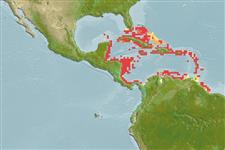Common names from other countries
Environment: milieu / climate zone / depth range / distribution range
Ecología
; rango de profundidad 0 - 7 m (Ref. 83435). Tropical; 26°N - 6°N, 89°W - 57°W
Distribución
Países | Áreas FAO | Ecosistemas | Ocurrencias, apariciones | Introducciones
Western Central Atlantic.
Length at first maturity / Tamaño / Peso / Age
Maturity: Lm ?, range 1 - 3.4 cm Max length : 18.0 cm SHW macho / no sexado; (Ref. 105349); common length : 10.0 cm TL macho / no sexado; (Ref. 355)
Shell large, heavy, conical, with rounded shoulders. Umbilicus deep and round, operculum multispiral, circular. Colour: purple-black on a whitish background; aperture white, internally nacreous; operculum iridescent brown.
Stocks have been locally extirpated or are diminishing due to over exploitation (Ref. 355). Shallow subtidal, on rocks and shell rubble (Ref. 355). They are also found in intertidal and offshore coral reefs, particularly on algae, boulder, and coral habitats (Ref. 83934). Herbivore-detritivore. Most feeding seems to occur at night and early morning. Feeds on a wide variety of algae, sand and detritus (Ref. 105349).
Broadcast spawners. Spawning occurs during lunar period. Females lay eggs in ribbons or jelly masses in the substratum, after the males have released their sperm (Ref. 105346). Males don't have penis (Ref. 105349). Life cycle: Embryos develop into planktonic trocophore larvae and later into juvenile veligers before becoming fully grown adults (Ref. 833).
Leal, J.H. 2003. (Ref. 355)
IUCN Red List Status (Ref. 130435)
CITES status (Ref. 108899)
Not Evaluated
Not Evaluated
Human uses
Pesquerías: comercial
| FishSource | Sea Around Us
Herramientas
Fuentes de Internet
Estimates based on models
Preferred temperature
(Ref.
115969): 26.8 - 28.2, mean 27.7 (based on 344 cells).
Resiliencia
Medio, población duplicada en un tiempo mínimo de 1.4-4.4 años (K=0.19-0.2).
Price category
Unknown.
